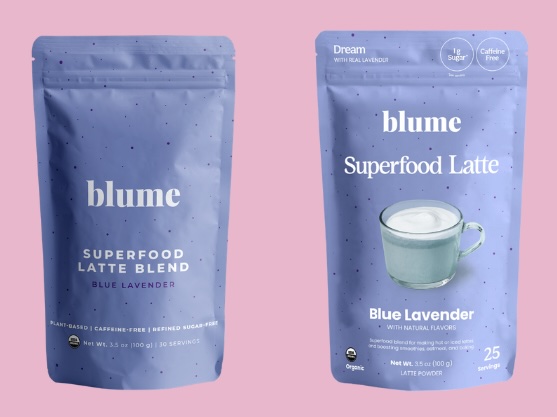Why Blume Superfood Lattes is betting on wholesale at retailers like Whole Foods

Before Blume Superfood Lattes landed on store shelves in Whole Foods this week, the company invested in redesigning its packaging — including an updated label that provides more information about serving sizes and a better explanation of product benefits.
That’s because the minimalist pouch that sells on its website wouldn’t pop on a store shelf the same way it does in website photography, co-founder and CEO Karen Danudjaja told Modern Retail.
“A minimalist package… is not going to help you stand out on a grocery shelf where people are really shopping based on function,” she said. “You’re competing in a totally different way with a thousand other products on that shelf.”
Blume — which makes powdered latte mixes — is launching its Matcha Coconut and Reishi Hot Chocolate flavors in 270 Whole Foods this week. Later this summer, the products are set to debut in Sprouts. The company, founded in 2017 in Canada, hit eight-figure revenue last year and saw 50% year-over-year growth, driven in part by its wholesale strategy that spreads across Canada and the United States in natural grocers like Bristol Farms and Erewhon, as well as a regional test at Target stores along the West Coast.
But the switch to wholesale means looking at the package differently. As brands seek to acquire new customers outside of online channels, it might mean figuring out a new look for the product. Other companies that have redesigned their packages as they hit store shelves include eco-friendly cleaning company Blueland and Asian sauce maker Omsom. Meanwhile, beverage brands like Zevia have experimented with single cans for grab-and-go opportunities.
Blume’s Danudjaja said the company has made a number of packaging changes to fit its retailer needs. As an international brand that first launched in Canada, it’s required to have French on the label for products there — and the measurements are in metrics. And when it launched in Target in the U.S. last fall, Blume created a box of eight single-serve pouches per the retailer’s request for a smaller package than the 3.5-ounce pouch sold for $25 online. Looking at the Whole Foods launch, the package includes more specific callouts like serving size, organic certification, larger ingredient labels and a photo of what a finished latte looks like.
Danudjaja said these changes can help catch the eye of a more price-conscious shopper who wants to know what they’re buying.
“Ultimately, we want it to be as easy as possible for the end consumer,” she said.
Blume is among a crop of DTC brands that are getting tapped for major retailer shelves as they seek to shake up their offerings. Target in particular has made a move toward superfoods, while Walmart has begun selling emerging brands like Pura diapers and a clothing line from Monica + Andy. But for brands, a big opportunity often leads to new problems to solve and challenges to tackle — whether that’s logistics, distribution, or changing up packaging.
Kevin Weiss, vp of retail media at omnichannel advertising platform Skai, said DTC brands in any sector are likely to hit a ceiling in the number of customers they can find online. That’s particularly true in the consumer packaged goods realm — especially with food items — since most consumers shop at grocery stores instead of shopping brand by brand. But there isn’t a simple copy-paste packaging playbook to bring the product onto shelves, Weiss said.
“When you’re in retail, you don’t have as much of a chance to make that emotional connection with the customer,” he said. “You have to sell differently and think about what are the other products on the shelves.”
Color schemes, labeling, instructions and bottle shape can all play a role in how the package looks — and the retailer may have thoughts to share, too. Weiss, who previously worked helping to scale DTC brands, recalled when the candy company Little Secrets was working on getting distribution with Starbucks. While Starbucks was interested in selling the product, it wanted to have the chocolate bars in vertical wrappers instead of horizontal to fit its shelves. “It was very specific,” he said.
Blume’s Danudjaja said the changes to the company’s look and operations are necessary as it seeks to continue to grow. “We want to have multiple legs to stand on. And so that really launched our grocery natural grocery push,” she said. “Part of our mission of being accessible is being where people are shopping and meeting them where they already are, versus being overly reliant on a Meta ad.”
